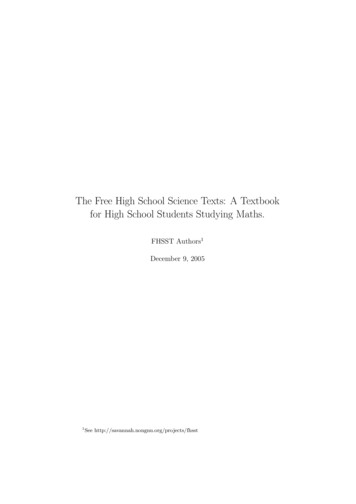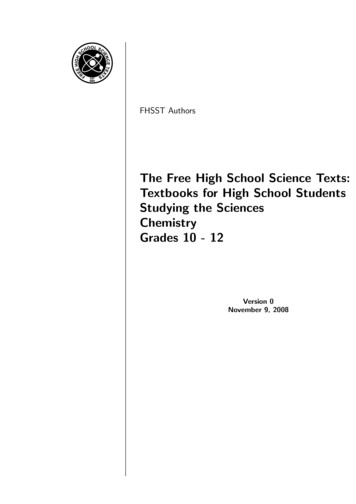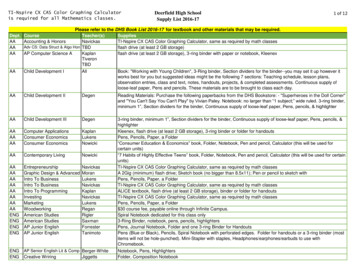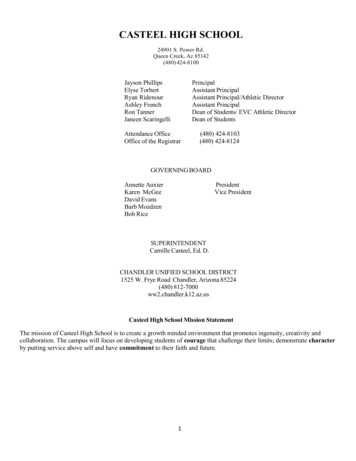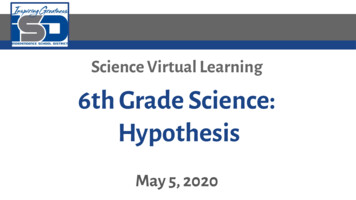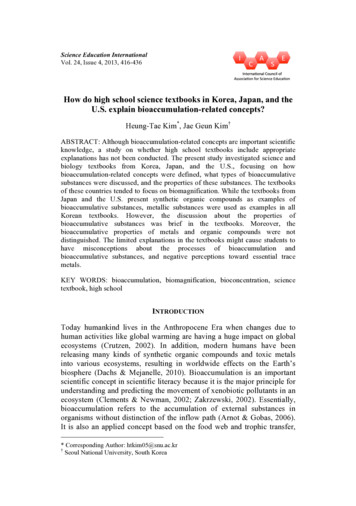
Transcription
Science Education InternationalVol. 24, Issue 4, 2013, on"for"Science"Educa,on"How do high school science textbooks in Korea, Japan, and theU.S. explain bioaccumulation-related concepts?Heung-Tae Kim*, Jae Geun Kim†ABSTRACT: Although bioaccumulation-related concepts are important scientificknowledge, a study on whether high school textbooks include appropriateexplanations has not been conducted. The present study investigated science andbiology textbooks from Korea, Japan, and the U.S., focusing on howbioaccumulation-related concepts were defined, what types of bioaccumulativesubstances were discussed, and the properties of these substances. The textbooksof these countries tended to focus on biomagnification. While the textbooks fromJapan and the U.S. present synthetic organic compounds as examples ofbioaccumulative substances, metallic substances were used as examples in allKorean textbooks. However, the discussion about the properties ofbioaccumulative substances was brief in the textbooks. Moreover, thebioaccumulative properties of metals and organic compounds were notdistinguished. The limited explanations in the textbooks might cause students tohave misconceptions about the processes of bioaccumulation andbioaccumulative substances, and negative perceptions toward essential tracemetals.KEY WORDS: bioaccumulation, biomagnification, bioconcentration, sciencetextbook, high schoolINTRODUCTIONToday humankind lives in the Anthropocene Era when changes due tohuman activities like global warming are having a huge impact on globalecosystems (Crutzen, 2002). In addition, modern humans have beenreleasing many kinds of synthetic organic compounds and toxic metalsinto various ecosystems, resulting in worldwide effects on the Earth’sbiosphere (Dachs & Mejanelle, 2010). Bioaccumulation is an importantscientific concept in scientific literacy because it is the major principle forunderstanding and predicting the movement of xenobiotic pollutants in anecosystem (Clements & Newman, 2002; Zakrzewski, 2002). Essentially,bioaccumulation refers to the accumulation of external substances inorganisms without distinction of the inflow path (Arnot & Gobas, 2006).It is also an applied concept based on the food web and trophic transfer,* Corresponding Author: htkim05@snu.ac.kr†Seoul National University, South Korea
Science Education Internationaland a core principle in ecotoxicology, a fusion of population ecology andtoxicology (Clements & Rohr, 2009).Knowledge about bioaccumulation is also important for the publicwith respect to a number of practical issues. People are always exposed tothe threat of synthetic chemicals in the air, water, and soil. Thus, inmodern times, we have an increased risk of environmental hormones thatlead to endocrine disorders (Rhind, 2009). Also, the danger frombioaccumulation of toxic substances expands a specific species-level riskto the ecosystem level through food chains (Rohr et al., 2006). Forexample, a specific bioaccumulative pollutant can be found in polaranimals without direct exposure to it (Blais et al., 2005). Because regionalproblems can become global problems, bioaccumulation needs to betreated as a global problem like climate change and biodiversity loss(Dachs & Méjanelle, 2010).From an education perspective, bioaccumulation-related concepts arealso important as a part of scientific literacy. Today humankind isaffecting all ecosystems more than even before (Crutzen, 2002). Thus, inorder to understand interactions between humans and environments on theecosystem level which are caused by the inflow of xenobiotic substancesinto the ecosystem, bioaccumulation-related concepts are necessaryknowledge and good materials for STS education. In addition,bioaccumulation-related concepts can be utilized for integrated scienceeducation, which is a concept that has been raised before (Pring, 1971).Bioaccumulation-related concepts are useful as they require chemicalknowledge about the molecular properties of substances, ecologicalknowledge about food chains, and physiological knowledge aboutorganisms’ responses to understand the concepts.Even though bioaccumulation is one of the important scientificprinciples needed to understand the relationship between humans and theenvironment at the ecosystem level, there is a lack of research onbioaccumulation-related content in scientific textbooks. According to anunpublished survey by the authors, biology teachers as well as studentswere found to have misconceptions about bioaccumulation. Theirmisconceptions were believed to be due to their textbooks and theyespecially tended to have a misinformed belief about the biomagnificationof toxic trace metals. Therefore, the purpose of this study was to examinethe bioaccumulation-related contents of science textbooks. Specifically,this study examines textbooks from Korea, Japan, and the U.S. in an effortto identify concepts presented that can give rise to fallacious beliefs ormisconceptions. Japanese use some Chinese characters as part of theirwriting and some of academic terms written in Chinese characters areshared by Korea and Japan. And the bioaccumulation-related terms wasdeveloped in the U.S. Thus, the textbooks from the three countries werechosen. In the following sections, a history of the definition of terms417
Science Education Internationalbioaccumulation, biomagnification, and bioconcentration is introduced toprovide the reader with an understanding of the differences between theseterms, especially with regards to the underlying processes for each one.Following this introduction, findings are compared and a new proposal forteaching bioaccumulation is shared.History and Definition of the TermsThere are three terms referring to the accumulation of substances inorganisms: bioaccumulation, biomagnification, and bioconcentration(Arnot & Gobas, 2006). First, bioaccumulation is an extensively usedterm meaning the accumulation of external substances in organismswithout distinction of the inflow path (Arnot & Gobas, 2006). It is theterm which was first used most widely after the discovery of accumulationin organisms (Connell, 1990).Since an increase in DDT concentration along food chains was foundin the 1960s (Woodwell, 1967), people have become concerned about thedanger of increased concentrations of residual substances in humans viaconsumption of animals and plants in the food chain. Since then, a newterm, biological magnification, or biomagnification, was introduced toindicate this phenomenon, which is specifically focuses on understandingthe process through dietary absorption (Woodwell et al., 1967). Thus,biomagnification mainly focuses on the inflow path through food,stressing its importance in bioaccumulation.However, experiments concerning accumulation in organisms in anaquatic environment did not always show clear evidence ofbiomagnification (Hamelink et al., 1971). This finding suggested that theabsorption of pollutants through the skin or respiratory organs might beimportant factors in bioaccumulation process. Thus the termbioconcentration, which indicates the processes of indirect absorptionthrough dermal and respiratory tissues separate from the indirectabsorption by food intake, began to be used (Streit, 1992).Since then, the field of ecotoxicology has come to define these termsas follows. Bioaccumulation refers to processes where a substance isabsorbed in direct or indirect ways, resulting in the concentration in theorganism being greater than in the respiratory medium (air or water)(Arnot & Gobas 2006; Gobas & Morrison, 2000). The English termbioaccumulation has been translated to the Korean term 생물축적, writtenas 生物蓄積 in Chinese characters (Park, 2009; The Korean Associationof Biological Sciences, 2005). Biomagnification is a special case ofbioaccumulation in which a substance’s concentration in an organismexceeds that in the organism’s diet due to dietary absorption (Mackay &Fraser, 2000). The English term biomagnification has been translated tothe Korean term 생물증폭, written as 生物增幅 in Chinese characters418
Science Education International(Park, 2009; The Korean Association of Biological Sciences, 2005). Incontrast, bioconcentration refers to processes by which a substance isabsorbed by an organism from the ambient environment only through anorganism’s respiratory and dermal surfaces and results in theconcentration of the chemical in the organism being greater than in theenvironment (Arnot & Gobas 2006; Gobas & Morrison, 2000). TheEnglish term bioconcentration has been translated to the Korean term생물농축, written as 生物濃縮 in Chinese characters. Therefore, theterms are differentiated by the inflow path of external substances.Processes of BioaccumulationSince bioaccumulation includes bioconcentration by direct absorption andbiomagnification by indirect absorption, bioaccumulation is a result of acombination of bioconcentration and food uptake (Gobas & Morrison,2000; Mackay & Fraser 2000). However, organisms do not just passivelyaccumulate external substances in the body. They also eliminate themthrough respiration, excretion, transformation by metabolism, growthdilution, and so on (Arnot & Gobas 2006). Therefore, the extent ofbioaccumulation is the net result of the competing processes of uptake andelimination. If bioaccumulation happens in an organism, biomagnificationwould not necessarily happen (Gray, 2002). In some organisms theconcentration level of some bioaccumulative substances can be higherthan in ambient environment, but not higher than in their prey. However,some predator organisms can have a concentration higher than in theirprey. That is, the bioaccumulation level may differ depending on thebiological organism, ecosystem, and substances involved (Connell, 1990).Above all, the highest risk is when the concentration of the toxicsubstance continuously increases along a food chain (Gobas et al., 2009).Properties of Bioaccumulative Organic ChemicalsChemical structure, molecular weight and shape, chemical stability, andionization affect the bioaccumulation of organic chemicals (Connell,1990). Bioaccumulative organic chemicals have the followingphysicochemical properties. They are usually aliphatic and aromaticcompounds, have mostly carbon-carbon and carbon-hydrogencombinations, and show a high proportion of carbon-halogen. In terms ofmolecular weight, bioaccumulation tends to increase from over 100, peakat about 350, and then decrease until about 600. Concerning molecularshape, the width of the cross-section is less than 9.5 Å, the surface area is208-460 Å2, and molecular volume is 260-760 Å3. In addition, they areresistant to degradation and stable for several years in the environment,and have very low ionization. Above all, fat-solubility is the most critical419
Science Education Internationalfactor for bioaccumulation. We can predict the bioaccumulation extent ofa specific substance if we know the fat-solubility (Gobas et al., 2009).Beyond these properties, biological factors such as lipid volume in thebody, species-specific metabolism, age, and reproduction cycle, andenvironmental factors such as chemical properties of water, such assalinity and pH, and temperature can also influence the extent ofbioaccumulation (Barron, 1990). These factors influence the absorptionand elimination of external substances, which affect the extent ofbioaccumulation. In terms of their effect on bioaccumulation, biologicalfeatures of organisms can be more critical than their trophic position infood webs (van Straalen, 2008). Therefore, it is necessary to consider avariety of factors when assessing the risk of bioaccumulative substances.Bioaccumulation of Trace MetalsBioaccumulative metals have different properties from organic chemicals.Metals are deposited as metallic compounds that are combined withorganic or inorganic ligands in organisms (Streit, 1992). Thus, metals canbe classified into three groups according to their combining power withligands, thus indicating their bioaccumulation potential. Metals in Class Ausually have a high affinity with ligands of oxygen, and Class B show ahigh affinity with nitrogen and sulfur. Metals in Borderline can form acomplex equally with oxygen, nitrogen, and sulfur. The toxicity of themetal depends on the group (Nieboer & Richardson, 1980). For example,mercury in Class B has relatively high toxicity because its ion has a highaffinity with ligands of nitrogen and sulfur, which are abundant inbiological tissues.In addition, the location where the toxic metals are stored in cells cancrucially determine the potential of food chain transfer (Hopkin, 1990).Metals usually are accumulated in the following five pools in a cell: 1. thecell membrane, 2. metal-rich granules, 3. metallothionein-like protein, 4.heat sensitive protein, and 5. cell organelles (Wang & Rainbow, 2006).Among these pools, the latter three regions (3, 4, and 5) accumulatemetals trophically available and thus the accumulated metals are mostlyabsorbed and assimilated by the predator (Wallace & Luoma, 2003).If they are stored in the regions easily degraded in the predator’sdigestive organs, they can be easily absorbed into the body. That is, theyare easily transferred to high trophic organisms through a food chain andtend to biomagnify. The distribution in a cell depends on the metal and thespecies, thus biomagnification differs among metals and food interactions(Hopkin, 1990).For example, the main way cadmium and lead are stored in a cell aremetallothionein protein and insoluble granules, respectively. Lead is in theBorderline group as well as cadmium, but biomagnification of lead rarely420
Science Education Internationaloccurs in ecosystems because the insoluble granule does not degrade welland can be easily excreted (Rubio-Franchini et al., 2008).Shortcomings of Knowledge about Bioaccumulation-related ConceptsKnowledge about the bioaccumulation of xenobiotics is part of
textbook, high school INTRODUCTION Today humankind lives in the Anthropocene Era when changes due to human activities like global warming are having a huge impact on global ecosystems (Crutzen, 2002). In addition, modern humans have been releasing many kinds of synthetic organic compounds and toxic metals into various ecosystems, resulting in worldwide effects on the Earth’s biosphere (Dachs .
